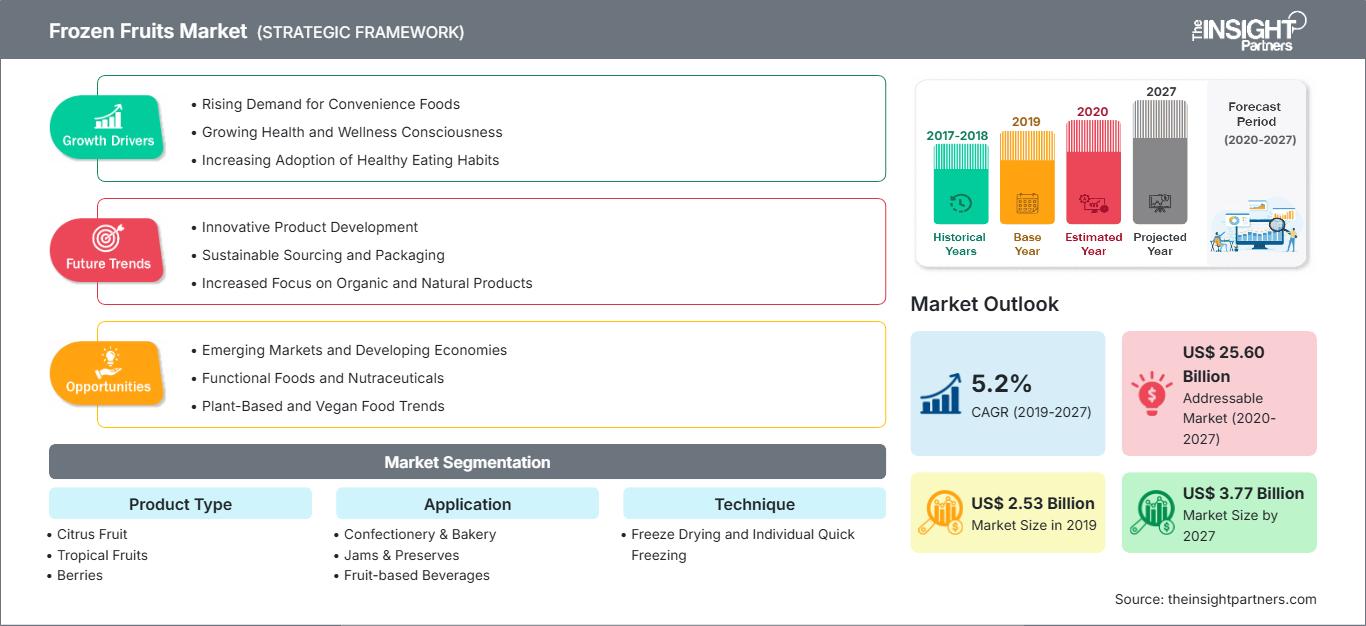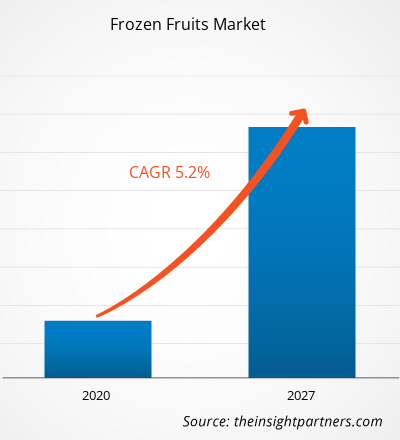[Forschungsbericht]Der Markt für Tiefkühlobst wurde 2019 auf 2.528,46 Millionen US-Dollar geschätzt und soll bis 2027 3.769,45 Millionen US-Dollar erreichen; im Prognosezeitraum wird ein durchschnittliches jährliches Wachstum von 5,2 % erwartet.
Obst, das auf dem Höhepunkt seiner Reife gepflückt wird, wird schockgefroren und bei flüssigem Stickstoff verpackt. Dieses Verfahren verlängert die Haltbarkeit des frischen Obstes. Wie frisches Obst ist auch Tiefkühlobst mit verschiedenen Antioxidantien, Mineralien und Vitaminen angereichert. Die im Vergleich zu frischem Obst leichte Verfügbarkeit von Tiefkühlobst, insbesondere von saisonalem Obst, treibt die weltweite Nachfrage nach Tiefkühlobst jedoch an.
Im Jahr 2019 hatte Europa den größten Anteil am globalen Markt für Tiefkühlobst, gefolgt von Nordamerika und dem asiatisch-pazifischen Raum. Deutschland und Frankreich dominieren den Markt für Tiefkühlobst in Europa. Neben der wachsenden Bevölkerung unterstützen auch steigende verfügbare Einkommen und ein aktiver Lebensstil, die die Nachfrage nach praktischen Snacks ankurbeln, das Wachstum des Marktes für Tiefkühlobst in Europa. Darüber hinaus hat die zunehmende Konzentration der Tiefkühlobstproduzenten auf die Einführung neuer Sorten von Tiefkühlobst, um eine größere Zahl von Verbrauchern anzulocken, das Marktwachstum in den europäischen Ländern weiter angekurbelt.
Der Ausbruch von COVID-19 begann im Dezember 2019 in Wuhan (China) und hat sich seitdem rasant weltweit verbreitet. Im November 2020 waren die USA, Brasilien, Indien, Russland, Südafrika, Mexiko und Großbritannien gemessen an bestätigten Fällen und gemeldeten Todesfällen einige der am schlimmsten betroffenen Länder. Der Ausbruch von COVID-19 hat aufgrund von Ausgangssperren, Reiseverboten und Geschäftsschließungen die Wirtschaft und Industrie in zahlreichen Ländern beeinträchtigt. Die Lebensmittel- und Getränkeindustrie ist eine der größten Branchen, die unter schwerwiegenden Störungen wie Unterbrechungen der Lieferkette, Absagen von Technologieveranstaltungen und Büroschließungen leidet. Die Schließung zahlreicher Werke und Fabriken in Regionen wie Nordamerika, Europa und im asiatisch-pazifischen Raum beeinträchtigt die globalen Lieferketten und wirkt sich negativ auf Produktion, Lieferpläne und Verkäufe aus. Darüber hinaus beeinträchtigen die weltweiten Reiseverbote die Möglichkeiten für geschäftliche Zusammenarbeit und Partnerschaften. Die Betriebsunterbrechungen in der Lebensmittel- und Getränkeindustrie haben das Wachstum des Marktes für Tiefkühlfrüchte in verschiedenen Ländern zusätzlich eingeschränkt.
Passen Sie diesen Bericht Ihren Anforderungen an
Sie erhalten kostenlos Anpassungen an jedem Bericht, einschließlich Teilen dieses Berichts oder einer Analyse auf Länderebene, eines Excel-Datenpakets sowie tolle Angebote und Rabatte für Start-ups und Universitäten.
Markt für gefrorene Früchte: Strategische Einblicke

-
Holen Sie sich die wichtigsten Markttrends aus diesem Bericht.Dieses KOSTENLOSE Beispiel umfasst Datenanalysen, die von Markttrends bis hin zu Schätzungen und Prognosen reichen.
Tiefkühlobst ist reich an Vitaminen, Proteinen, Kohlenhydraten, Antioxidantien und anderen Nährstoffen. Es wird in verschiedenen Küchen verwendet, um Nährstoffe und Geschmack zu verbessern. Tiefkühlobst wird in der Lebensmittelindustrie eingesetzt und in Backwaren, Süßwaren und anderen verpackten Lebensmitteln verarbeitet. Auch Marmelade und andere Fruchtaufstriche, Fruchtgetränke und Milchprodukte werden daraus hergestellt. Aufgrund des hektischen Alltags ist der Konsum dieser verzehrfertigen Lebensmittel und Getränke in den letzten Jahren deutlich gestiegen. Steigendes verfügbares Einkommen und eine verbesserte Wirtschaftslage ermutigen Verbraucher in Industrie- und Entwicklungsländern zudem, mehr Geld für verpackte Lebensmittel wie Snacks und Backwaren auszugeben, was die Nachfrage nach Tiefkühlobst weiter ankurbelt. Die Diversifizierung der Vertriebskanäle hat zudem Convenience Food in Einzelhandelsgeschäften und Supermärkten verfügbar gemacht und so deren Umsätze gesteigert. Somit treibt die wachsende Nachfrage aus der verpackten und verarbeiteten Lebensmittelindustrie sowie von Direktverbrauchern den Markt für Tiefkühlfrüchte an.
Einblicke in Produkttypen
Der Markt für Tiefkühlfrüchte ist nach Produkttyp in Zitrusfrüchte, tropische Früchte, Beeren und andere unterteilt. Im Jahr 2019 dominierte das Segment der tropischen Früchte den Markt für Tiefkühlfrüchte. Viele tiefgekühlte tropische Früchte wie Mango, Papaya, Apfel, Litschi, Banane, Drachenfrucht, Pflaume, Guave und Passionsfrucht liegen weltweit im Trend. Neben dem Einfrieren können die Hersteller diese Früchte auch durch Waschen, Schälen, Sortieren, Schneiden, Blanchieren, Deaktivieren der Enzymaktivität usw. verarbeiten, je nachdem, welche Form das Endprodukt haben soll. Tiefgekühlte tropische Früchte werden in Fruchtcocktails, Smoothies, Eiscreme, Desserts, Konservierungsmitteln, Gebäck, Joghurt und Getränken verwendet. Zu den tropischen Früchten, die vorwiegend für die Verarbeitung ethnischer Lebensmittel verwendet werden, gehören gefrorene Mangos (Chutney), gefrorene Avocados (Guacamole) und Guaven (Ponche Navideño). Die zunehmende Verwendung tropischer Früchte in verschiedenen Produkten dürfte den Markt dieses Segments ankurbeln.
Anwendungseinblicke
Basierend auf der Anwendung ist der Markt für gefrorene Früchte in Süßwaren und Backwaren, Marmeladen und Konfitüren, Fruchtgetränke, Milchprodukte und Sonstiges unterteilt. Im Jahr 2019 dominierten die Segmente Süßwaren und Backwaren den Markt für gefrorene Früchte. Gefrorene Früchte werden zunehmend in Back- und Süßwarenprodukten sowie Milchprodukten wie Joghurt und Eiscreme verwendet. Darüber hinaus ist die Nachfrage nach gefrorenen Früchten aus dem Segment der Fruchtgetränke aufgrund der zunehmenden Vorliebe der Verbraucher für gesunde Getränke erheblich gestiegen. Die zunehmende Vorliebe für Bio-Lebensmittel stimuliert auch das Wachstum des Marktes für Tiefkühlobst.
Technische Einblicke
Basierend auf der Technik ist der Markt für Tiefkühlobst in Gefriertrocknung und individuelles Schnellgefrieren (IQF) segmentiert. Das Segment Gefriertrocknung hatte 2019 einen größeren Marktanteil und das Segment individuelles Schnellgefrieren wird zwischen 2020 und 2027 voraussichtlich die schnellste CAGR verzeichnen. Beim Gefriertrocknungsverfahren wird das Obst eingefroren und anschließend in ein Vakuum gelegt. Durch den niedrigen Druck wachsen die Eiskristalle exponentiell und verwandeln sich direkt von festem Eis in Wasserdampf. Bei dieser Methode wird Wasser noch schneller extrahiert als beim herkömmlichen Trocknungsprozess. Tatsächlich wird der Wassergehalt des Obstes verringert, ohne seine Zusammensetzung zu beeinträchtigen. Diese Methode der Lebensmittelkonservierung eignet sich am besten für zuckerarme, weiche Früchte wie Himbeeren und Erdbeeren. Durch Gefriertrocknung werden Früchte länger haltbar und bleiben bei richtiger Lagerung viele Jahre haltbar.
Zu den wichtigsten Marktteilnehmern zählen Crop's Fruits NV, Dole Packaged Foods LLC., MireliteMirsa Co. Ltd., SunOpta Inc., Titan Frozen Fruits, Wawona Frozen Foods, Welch Foods, Inc., Greenyard, JR Simplot Company und General Mills Inc. Die Unternehmen verfolgen Strategien wie Fusionen und Übernahmen. Die großen Akteure streben durch die Ausweitung ihrer globalen Präsenz eine größere Kundenbasis an.
Markt für Tiefkühlfrüchte
Die Analysten von The Insight Partners haben die regionalen Trends und Faktoren, die den Markt für Tiefkühlfrüchte im Prognosezeitraum beeinflussen, ausführlich erläutert. In diesem Abschnitt werden auch die Marktsegmente und die geografische Lage in Nordamerika, Europa, dem asiatisch-pazifischen Raum, dem Nahen Osten und Afrika sowie Süd- und Mittelamerika erörtert.Umfang des Marktberichts über Tiefkühlfrüchte
| Berichtsattribut | Einzelheiten |
|---|---|
| Marktgröße in 2024 | US$ 35.15 Billion |
| Marktgröße nach 2031 | US$ 47.74 Billion |
| Globale CAGR (2025 - 2031) | 4.5% |
| Historische Daten | 2021-2023 |
| Prognosezeitraum | 2025-2031 |
| Abgedeckte Segmente |
By Art
|
| Abgedeckte Regionen und Länder |
Nordamerika
|
| Marktführer und wichtige Unternehmensprofile |
|
Dichte der Marktteilnehmer für Tiefkühlfrüchte: Auswirkungen auf die Geschäftsdynamik verstehen
Der Markt für Tiefkühlfrüchte wächst rasant. Die steigende Nachfrage der Endverbraucher ist auf Faktoren wie veränderte Verbraucherpräferenzen, technologische Fortschritte und ein stärkeres Bewusstsein für die Produktvorteile zurückzuführen. Mit der steigenden Nachfrage erweitern Unternehmen ihr Angebot, entwickeln Innovationen, um den Bedürfnissen der Verbraucher gerecht zu werden, und nutzen neue Trends, was das Marktwachstum weiter ankurbelt.
- Holen Sie sich die Markt für gefrorene Früchte Übersicht der wichtigsten Akteure
- Progressive Branchentrends auf dem globalen Markt für Tiefkühlfrüchte, um Akteuren bei der Entwicklung effektiver langfristiger Strategien zu helfen
- Geschäftswachstumsstrategien von Unternehmen, um in entwickelten und sich entwickelnden Märkten zu wachsen
- Quantitative Analyse des globalen Marktes für Tiefkühlfrüchte von 2017 bis 2027
- Schätzung der Nachfrage nach Tiefkühlfrüchten in verschiedenen Branchen
- PEST-Analyse zur Veranschaulichung der Wirksamkeit von Käufern und Lieferanten, die in der Branche tätig sind, um das Marktwachstum vorherzusagen
- Jüngste Entwicklungen zum Verständnis des Wettbewerbsmarktszenarios und der Nachfrage nach Tiefkühlfrüchten
- Markttrends und -aussichten sowie Faktoren, die das Wachstum des Marktes für Tiefkühlfrüchte fördern und hemmen
- Verständnis von Strategien, die das kommerzielle Interesse im Hinblick auf das Wachstum des globalen Marktes für Tiefkühlfrüchte untermauern, um den Entscheidungsprozess für Stakeholder zu erleichtern
- Marktgröße für Tiefkühlfrüchte an verschiedenen Marktknotenpunkten
- Detaillierte Übersicht und Segmentierung des globalen Marktes für Tiefkühlfrüchte sowie seine Dynamik in der Branche
- Marktgröße für Tiefkühlfrüchte in verschiedenen Regionen mit vielversprechenden Wachstumschancen
Markt für Tiefkühlfrüchte nach Produkttyp
- Zitrusfrüchte
- Tropische Früchte
- Beeren
- Sonstige
Markt für Tiefkühlfrüchte nach Anwendung
- Süßwaren und Backwaren
- Marmeladen und Konserven
- Fruchtgetränke
- Milchprodukte
- Sonstige
Markt für Tiefkühlfrüchte nach Verfahren
- Gefriertrocknung
- Einzelnes Schnellgefrieren
Firmenprofile
- Crop's Fruits NV
- Dole Packaged Foods LLC.
- MireliteMirsa Co. Ltd.
- SunOpta Inc.
- Titan Frozen Fruits
- Wawona Frozen Foods
- Welch Foods Inc.
- Greenyard
- JR Simplot Company
- General Mills Inc
- Historische Analyse (2 Jahre), Basisjahr, Prognose (7 Jahre) mit CAGR
- PEST- und SWOT-Analyse
- Marktgröße Wert/Volumen – Global, Regional, Land
- Branchen- und Wettbewerbslandschaft
- Excel-Datensatz
Aktuelle Berichte
Verwandte Berichte
Erfahrungsberichte
Grund zum Kauf
- Fundierte Entscheidungsfindung
- Marktdynamik verstehen
- Wettbewerbsanalyse
- Kundeneinblicke
- Marktprognosen
- Risikominimierung
- Strategische Planung
- Investitionsbegründung
- Identifizierung neuer Märkte
- Verbesserung von Marketingstrategien
- Steigerung der Betriebseffizienz
- Anpassung an regulatorische Trends






















 Kostenlose Probe anfordern für - Markt für gefrorene Früchte
Kostenlose Probe anfordern für - Markt für gefrorene Früchte